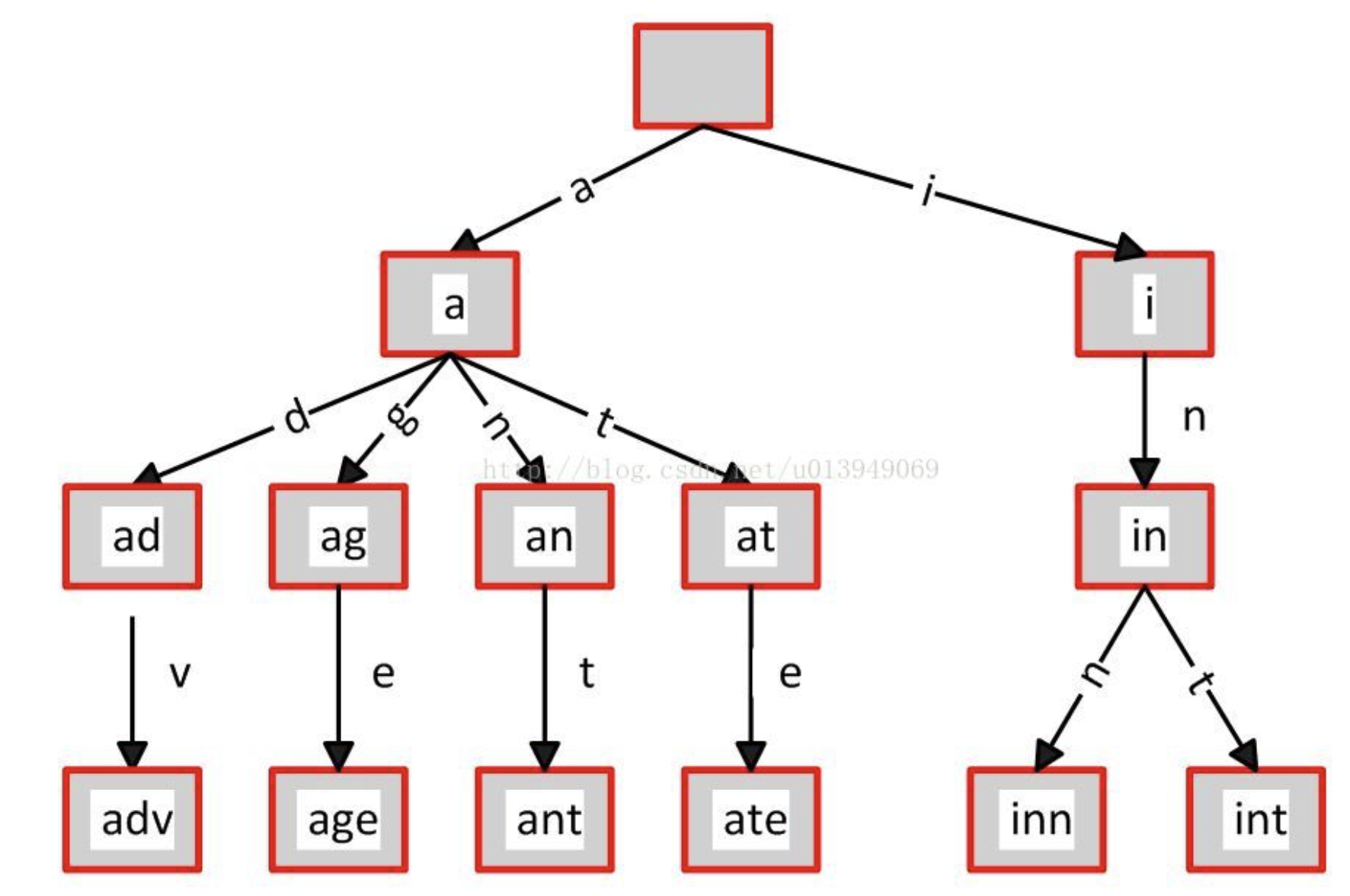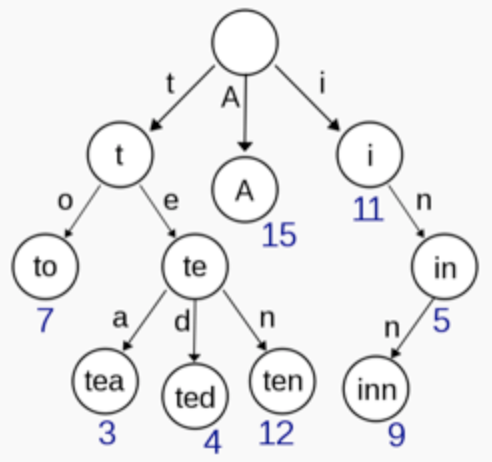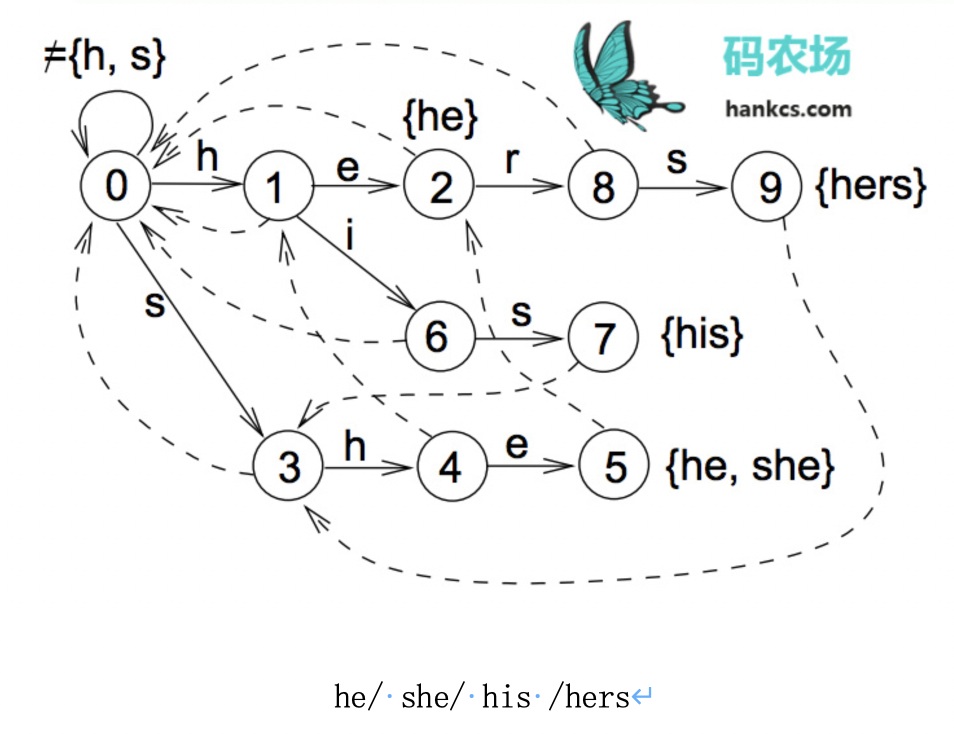实现
python版本
class Trie:# word_end = -1def __init__(self):"""Initialize your data structure here."""self.root = {}self.word_end = -1def insert(self, word):"""Inserts a word into the trie.:type word: str:rtype: void"""curNode = self.rootfor c in word:if not c in curNode:curNode[c] = {}curNode = curNode[c]curNode[self.word_end] = Truedef search(self, word):"""Returns if the word is in the trie.:type word: str:rtype: bool"""curNode = self.rootfor c in word:if not c in curNode:return FalsecurNode = curNode[c]# Doesn't end hereif self.word_end not in curNode:return Falsereturn Truedef startsWith(self, prefix):"""Returns if there is any word in the trie that starts with the given prefix.:type prefix: str:rtype: bool"""curNode = self.rootfor c in prefix:if not c in curNode:return FalsecurNode = curNode[c]return True# Your Trie object will be instantiated and called as such:# obj = Trie()# obj.insert(word)# param_2 = obj.search(word)# param_3 = obj.startsWith(prefix)
Trie树和其他几种树的比较
二叉搜索树相比
二叉搜索树又叫二叉排序树,Trie 树是N 叉树,其一个重要性质是左节点小于根节点的值,右节点都大于根节点的值,Trie 更适合字符串的场景,如果处理浮点数的话,就可能导致整个 Trie 树巨长无比,节点可读性也非常差。
Hash 表相比
省内存,解决Hash 表键冲突的问题。
hash 精确查找,trie 树用于解决前缀检索的场景。
但是在精确查找的场景,hash要比trie快很多。
:::info
hash 精确查找可以做到O(1),模糊查找需要进行匹配,时间复杂度是O(mn),m是词的个数,平均水平是o(n)
:::
后缀树相比
后缀树:就是把一串字符的所有后缀保存并且压缩的字典树,
前缀树:不同字符串的相同前缀只保存一份。
在算法题中许多关于 “前缀子串”问题上,我们经常使用 Trie 树来求解,但是如果问题仅仅涉及 “子串”,往往选用后缀树;

后缀树 前缀树
比如:查找某个字符串s1是否在另外一个字符串s2中。这个很简单,如果s1在字符串s2中,那么s1必定是s2中某个后缀串的前缀。
法1:遍历S2,如果S2中的字符开始和S1 中的字符一样,就开始计数,如果不一样就重新开始计数,最后判断最长的计数和S1 的长度是不是一样。
法2:例如S2: banana,查找S1:nan是否在S2中,则S1(nan)必然是S2(banana)的后缀之一nana的前缀,只需要查找叶子结点就行。
应用场景
1.字符串检索
事先将已知的一些字符串(字典)的有关信息保存到trie树里,查找另外一些未知字符串是否出现过或者出现频率。
- 敏感词检测,有敏感词词表。
1000万字符串,其中有些是重复的,需要把重复的全部去掉,保留没有重复的字符串。
2.词频统计
有一个1G大小的一个文件,里面每一行是一个词,词的大小不超过16字节,内存限制大小是1M。返回频数最高的100个词。
- 一个文本文件,大约有一万行,每行一个词,要求统计出其中最频繁出现的前10个词,请给出思想,给出时间复杂度分析。
若无内存限制:Trie + “k-大/小根堆”(k为要找到的数目)。
若有内存限制:先hash分段再对每一个段用hash(另一个hash函数)统计词频,再要么利用归并排序的某些特性(如partial_sort),要么利用某使用外存的方法。
3.文本预测-字符串公共前缀
-
4.排序
Trie树是一棵多叉树,只要先序遍历整棵树,输出相应的字符串便是按字典序排序的结果。
比如给你N 个互不相同的仅由一个单词构成的英文名,让你将它们按字典序从小到大排序输出。
Trie树改进
分支压缩:对于稳定的 Trie 树,基本上都是查找和读取操作,完全可以把一些分支进行压缩。例如,前图中最右侧分支的 inn 可以直接压缩成一个节点 “inn”,而不需要作为一棵常规的子树存在。Radix 树就是根据这个原理来解决 Trie 树过深问题的。

- 节点映射表:这种方式也是在 Trie 树的节点可能已经几乎完全确定的情况下采用的,针对 Trie 树中节点的每一个状态,如果状态总数重复很多的话,通过一个元素为数字的多维数组(比如 Triple Array Trie)来表示,这样存储 Trie 树本身的空间开销会小一些,虽说引入了一张额外的映射表。😥
变种树
AC树
AC 自动机,是在 Trie 树的基础上进行优化,当匹配失败时,跳转到指向与当前字符将主串重新匹配的位置向后多移动几位。
匹配过程:
假设待匹配文本为”hisshers”,那么状态转移为:0->1->6->7->3 ->0->3->4->5->2 ->8->9,文本仅扫描了一遍,依次输出结果”his”、”she”、”he”、”he”、”hers”。
比如一个字符串shers,she模式是含有hers模式的前缀he,当在状态5匹配失效时跳转到状态2继续匹配。Ac 树比一般字典树高效的一个关键点。代码就是每个树多了一个node指针。golang版本
```go import ( “unicode/utf8” )
type node struct { next map[rune]node fail node wordLength int }
type Trie struct { root *node nodeCount int }
// New returns an empty aca. func New() Trie { return &Trie{root: &node{}, nodeCount: 1} } func (T Trie) InitRootNode() { n := new(node) n.fail = nil n.next = make(map[rune]*node) n.wordLength = 0
}
// Add adds a new word to aca. // After Add, and before Find, // MUST Build. func (T Trie) Add(word string) { n := T.root for _, r := range word { //hers // fmt.Println(“r”,r) if n.next == nil { n.next = make(map[rune]node) } if n.next[r] == nil { n.next[r] = &node{} T.nodeCount++ } n = n.next[r] } n.wordLength = len(word) }
// Del delete a word from aca. // After Del, and before Find, // MUST Build. func (T Trie) Del(word string) { rs := []rune(word) //rs:=word stack := make([]node, len(rs)) n := T.root
for i, r := range rs {if n.next[r] == nil {return}stack[i] = nn = n.next[r]}// if it is NOT the leaf nodeif len(n.next) > 0 {n.wordLength = 0return}// if it is the leaf nodefor i := len(rs) - 1; i >= 0; i-- {stack[i].next[rs[i]].next = nilstack[i].next[rs[i]].fail = nildelete(stack[i].next, rs[i])T.nodeCount--if len(stack[i].next) > 0 ||stack[i].wordLength > 0 {return}}
}
// BuildTrie for Agentids, It MUST be called before Find. func (T *Trie) BuildTrie(dictionary [][]byte) { for _, line := range dictionary { if len(line) <= 0 { continue } T.Add(string(line)) } T.Build() }
//Build BuildTrie func (T Trie) Build() { // allocate enough memory as a queue q := append(make([]node, 0, T.nodeCount), T.root) for len(q) > 0 { n := q[0] q = q[1:]
for r, c := range n.next {q = append(q, c)p := n.fail //n:hfor p != nil {// ATTENTION: nil map cannot be writen// but CAN BE READ!!!if p.next[r] != nil { //fail 指针指针的r指针也是存在,fail 指针进行链接,链接完跳出循环c.fail = p.next[r] //r:ebreak}p = p.fail //指向自己的fail指针}if p == nil {c.fail = T.root //fail指针指向root}}}
}
func (T *Trie) find(s string, cb func(start, end int)) { n := T.root for i, r := range s { for n.next[r] == nil && n != T.root { n = n.fail } n = n.next[r] if n == nil { n = T.root continue }
end := i + utf8.RuneLen(r)for t := n; t != T.root; t = t.fail {if t.wordLength > 0 {cb(end-t.wordLength, end)}}}
}
// Find finds all the words contains in s. // The results may duplicated. // It is caller’s responsibility to make results unique. func (T *Trie) Find(s string) (words []string) {
T.find(s, func(start, end int) {//charactor, length := utf8.DecodeRune(s[start:end])words = append(words, s[start:end])})return
}
问题
Trie 树一般用于什么场景?
:::info Trie树,是一种树形结构,用于保存关联数组。典型应用是用于统计,排序和保存大量的字符串(但不仅限于字符串)。 :::
Trie 树有哪些优点?
:::info
- 最坏情况时间复杂度比hash表好。
- 没有冲突,除非一个key对应多个值(除key外的其他信息)。
自带排序功能(类似Radix Sort),中序遍历trie可以得到排序。 :::
Trie 树有哪些缺点?
:::info
虽然不同单词共享前缀,但其实trie是一个以空间换时间的算法。其每一个字符都可能包含至多字符集大小数目的指针。
- 如果数据存储在外部存储器等较慢位置,Trie会较hash速度慢(hash访问O(1)次外存,Trie访问O(树高))。
- 长的浮点数等会让链变得很长。可用bitwise trie改进或者直接用二叉排序树就好了。
:::
时间复杂度?
:::info 创建时间复杂度为O(n)
插入和搜索的代价是O(n)
查询时间复杂度是O(logn),查询时间复杂度最坏情况下是O(n),n是字符串的长度 :::

